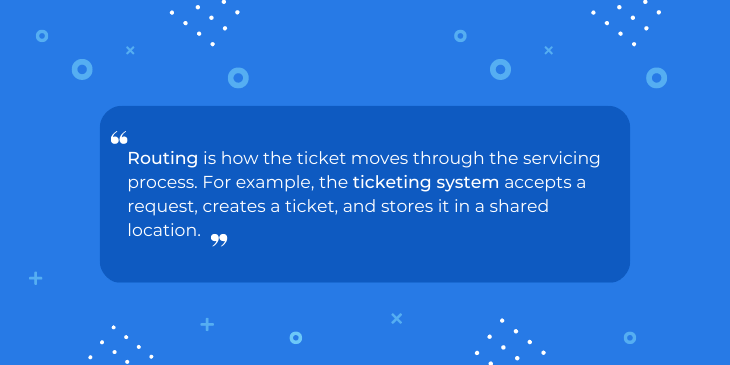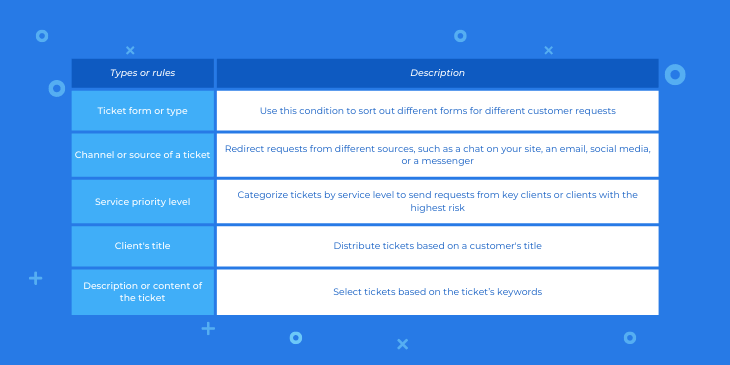With some customer support services, you wait on the phone for what seems like forever, listen to Beethoven's "Für Elise" on repeat 10 times, and slowly start to hate the support service of the company you called, the great composer, and the whole world. Does this ever happen to you as a customer? As a service provider, you know that in this scenario, what’s happening behind the scenes is that your support reps are looking for someone who can address the customer's request. No one likes being left on hold for a long time.
Luckily, you can easily avoid long wait times with automated ticket routing. Here’s how it works: Ticketing software automatically assigns customer requests to a support agent who has the time and expertise to assist the customer. Consequently, the company doesn't need to keep customers on the line while the team frantically searches for someone who’s not busy.
If you’re not sure whether automated ticket routing is right for you, but you want to reduce support wait times and avoid repeat calls to support, read on. We’ll explain automated ticket routing and why you need it.
What Is the Ticketing Process?
Let's start from the beginning. Your support team must perform several tasks to serve customers. They accept a help request, assign it to a support representative, discuss and resolve the issue with a customer, and receive feedback.
But it’s only the tip of the iceberg. Once a customer contacts a support service for help, a help desk agent creates a ticket. It’s a digital record with all the relevant information, such as the customer name, email, phone number, details on the issue in question, and so on. The support team can collect this information as you interact with the customer in a phone call or text chat or offer a contact form with all the necessary fields. Once the issue is resolved, a support agent closes the ticket, which is then stored in the system. That’s the basics of the ticketing process.

The good news is, customer service software can automate the ticketing process in many ways. Some legacy ticketing systems create all tickets automatically and then support agents distribute them manually. Other software may also help customers with common issues by sending them to a FAQ section of a website or using artificial intelligence to write answers.
Most modern apps are somewhere in the middle. They have ticket routing features that greatly speed up workflow while human support reps communicate with customers. Let’s consider how ticket routing helps in more detail.
What Is Ticket Routing?
In simple words, routing is how the ticket moves through the servicing process. For example, the ticketing system accepts a request, creates a ticket, and stores it in a shared location. One of the support agents selects this ticket, assigns it to themself, helps the client, and closes the ticket. If the rep feels they don't have the expertise to assist the client, they assign the ticket to a colleague who can help.
Such a lengthy and inconvenient process is typical for manual routing. Its automated alternative makes everything much simpler. Guided by pre-set rules, when a customer makes a support inquiry, the help desk system assigns a ticket to an available agent with the right expertise to help the customer. This way, support agents don’t waste time cherry-picking and assigning tickets, the workload is spread out more evenly, and it helps agents serve customers faster.

Of course, a support rep can reassign a ticket manually if the support system makes a mistake. But don't worry; this rarely happens if you set the routing rules correctly and choose the appropriate distribution method. Automating ticket routing is pretty simple, and we’ll help you learn the basics.
How to Automate Ticket Routing
Of course, you could design an automated ticketing routing solution on your own. But why take on a lengthy and costly development process? There are plenty of commercial help desk systems with ticket routing automation capabilities available on the market. Just bear in mind that some of these solutions are better than others and each has its own settings and capabilities. But don’t worry — in most cases, they’re very intuitive.
For instance, here’s how you set up skill-based ticket routing in Freshdesk. Say you want the system to send a customer’s inquiry regarding errors in a payment system to a senior support manager. You need to:
- Log in and go to Admin > Workflows > Automations.
- Click New Rule.
- When a window appears, give a name to the rule.
- Select one or more conditions from the drop-down list. If you don't find a suitable topic, select Subject and Description and type it out — "payment system doesn't work," in our case. You can add more conditions, like, for example, the source of the ticket, such as email.
- Next, you select one or more actions the system should take with a ticket if the chosen condition is met. For example, you can use Assign to Agent and choose the role or name of the responsible agent (let's say, a senior support manager). We also can add more actions, such as sending an email notification to a manager.
- In the same window, mark the priority as low, medium, or high and add a corresponding tag.
- When finished, click Preview and Save to see the rule summary.
That's all there is to set up automated ticket routing. This convenient scenario assigns the right support agents to address the customer’s needs, and address them quickly. The most important step is setting up distribution (tagging) rules as needed.
Ticket Distribution Scheme: The Most Common Types of Rules
Support teams build ticket distribution rules based on different conditions, such as which communication channel the request came from, specific skills an employee might have, or priority. Each help desk automation service has its own set of criteria, but since they’re similar across services, below we describe them only generally, to show how you can customize your ticketing tool.
- Ticket form or type. If you have different forms for different customer requests, you need to set this condition to sort them. For example, if a customer wants to return an item and uses a corresponding fill-out form, a rule based on the request form sends the ticket to the Returns and Refunds department.
- Channel or source of a ticket. You can automatically redirect requests from different sources, such as a chat on your site, an email, social media, or a messenger to specific specialists. Suppose you’re using Instagram to accept tickets. In that case, you can create a rule that redirects all requests received through Instagram to an agent who specializes in this social media platform.
- Service priority level. You can categorize tickets by service level to send requests from key clients or clients with the highest risk to the support agents most skilled in a particular issue. How you determine this priority is up to you since the system only relies on a given algorithm. For example, as a bookstore, you can prioritize requests from customers who spent more than $100 on books per month and route their tickets to the manager responsible for issuing loyalty discounts.
- Client's title. If you’re engaged in B2B sales, you may need to distribute tickets based on a customer's title. For example, if an ordinary manager submits a request, managers of the same level can process it. But, if a company's CEO sent a letter, you'd better pass the ticket along to senior management.
- Description or content of the ticket. The ticketing system can also select tickets based on the ticket’s keywords and send them to the appropriate specialists. For example, if a client complains about "terrible service" or writes "do not recommend," you can specify in the rule that a complaints manager must work with this ticket.

Setting up these tagging rules helps you distribute customer requests based on a customer’s needs and your support reps’ capabilities. As a result of automating, the quality of customer service improves, and staffing costs drop.
Wrapping Up
Automated ticket routing saves your resources. The help desk system itself assigns customers' requests to agents, depending on their specialties and workload, benefiting service quality and workflow. All you need to do is determine who will work with the different ticket types, and why.
The automatic ticket routing function works best with other automation features, such as chatbots and analytics, and fortunately, you don't have to select, define, and combine them yourself. Most help desk providers combine automated ticketing processes with other features to keep your business processes as smooth as silk.



